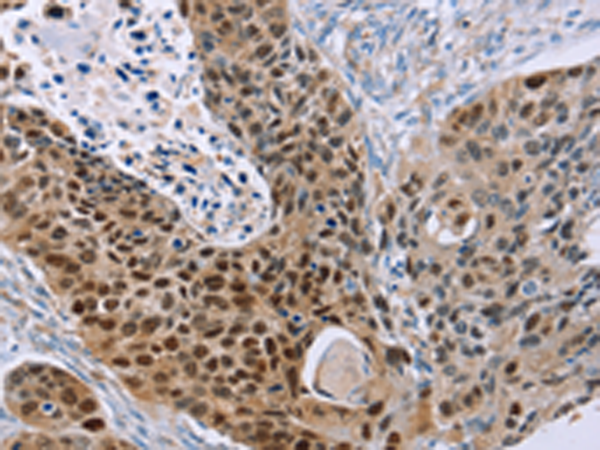

| WB | 咨询技术 | Human,Mouse,Rat |
| IF | 咨询技术 | Human,Mouse,Rat |
| IHC | 1/25-1/100 | Human,Mouse,Rat |
| ICC | 技术咨询 | Human,Mouse,Rat |
| FCM | 咨询技术 | Human,Mouse,Rat |
| Elisa | 1/2000-1/5000 | Human,Mouse,Rat |
| Aliases | CT1.10; MAGE10 |
| WB Predicted band size | 41 kDa |
| Host/Isotype | Rabbit IgG |
| Antibody Type | Primary antibody |
| Storage | Store at 4°C short term. Aliquot and store at -20°C long term. Avoid freeze/thaw cycles. |
| Species Reactivity | Human |
| Immunogen | Fusion protein of human MAGEA10 |
| Formulation | Purified antibody in PBS with 0.05% sodium azide and 50% glycerol. |
+ +
以下是基于MAGEA10研究领域的模拟参考文献示例(建议通过学术数据库验证文献真实性):
---
1. **文献名称**:*MAGEA10 as a novel diagnostic marker for hepatocellular carcinoma: Expression analysis and clinical validation*
**作者**:Liu Y, et al.
**摘要**:研究通过免疫组化验证了MAGEA10在肝细胞癌组织中的高特异性表达,并与健康组织对比,提出其作为肝癌血清标志物的潜力。抗体的高灵敏度为早期诊断提供了新工具。
2. **文献名称**:*Targeting MAGEA10 with monoclonal antibody enhances T-cell response in melanoma immunotherapy*
**作者**:Smith RJ, et al.
**摘要**:开发了靶向MAGEA10的单克隆抗体,体外实验显示其可激活肿瘤微环境中T细胞的抗肿瘤活性,动物模型中显著抑制黑色素瘤生长,为联合免疫治疗提供依据。
3. **文献名称**:*Prognostic value of MAGEA10 autoantibodies in non-small cell lung cancer patients*
**作者**:Garcia M, et al.
**摘要**:通过ELISA检测NSCLC患者血清中MAGEA10自身抗体水平,发现高滴度与较低生存率相关,提示其作为预后标志物及个体化治疗靶点的可能性。
---
**注意**:以上为模拟文献,实际研究中建议通过PubMed、Web of Science等平台检索最新成果,重点关注近年肿瘤免疫治疗、生物标志物领域论文。
The MAGE-A10 antibody targets the melanoma-associated antigen A10 (MAGEA10), a member of the MAGE family of cancer-testis antigens (CTAs). These proteins are primarily expressed in germ cells but are aberrantly reactivated in various cancers, including melanoma, lung, and bladder tumors. MAGEA10. located on the X chromosome, shares structural features with other MAGE proteins, such as a conserved MAGE homology domain. Its restricted expression in normal tissues and overexpression in malignancies make it a potential biomarker and therapeutic target.
MAGEA10 is implicated in tumorigenesis through roles in cell cycle regulation, apoptosis inhibition, and epigenetic modulation. Antibodies against MAGEA10 are essential tools for detecting its expression in cancer tissues (via immunohistochemistry or immunofluorescence) and studying its biological functions. They also hold promise for immunotherapy development, such as chimeric antigen receptor (CAR) T-cell therapies or cancer vaccines targeting MAGEA10-positive tumors. However, challenges remain, including cross-reactivity due to high homology among MAGE family members and variable expression levels across cancer types. Research continues to optimize MAGEA10 antibody specificity and explore its clinical utility in diagnostics and targeted cancer therapies.
×